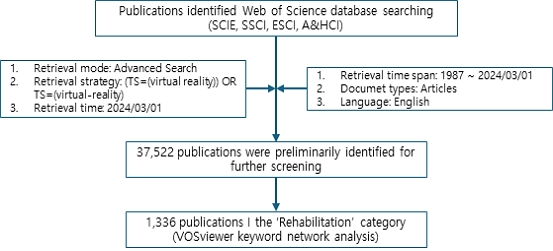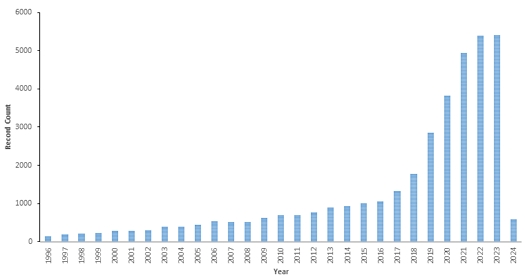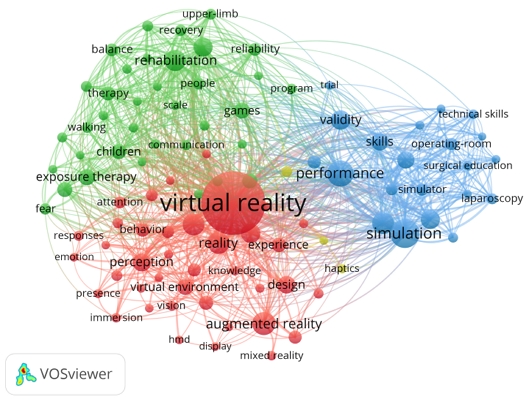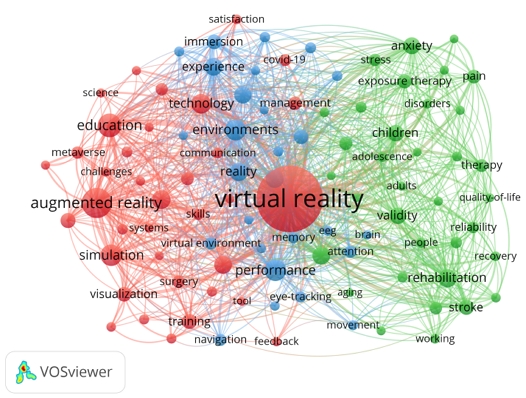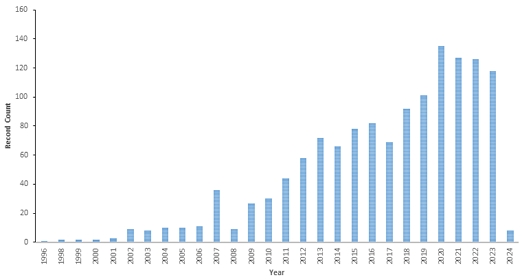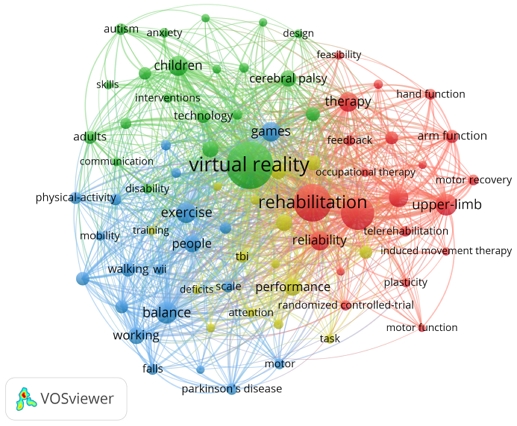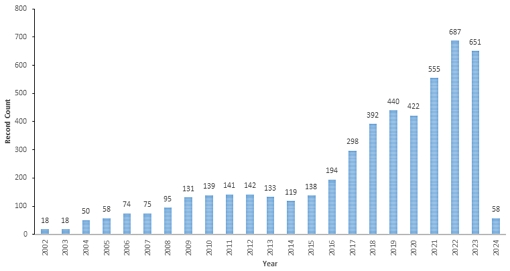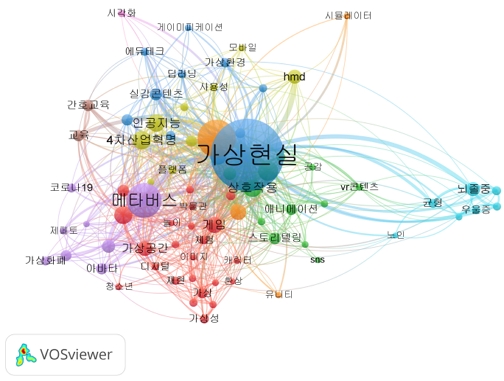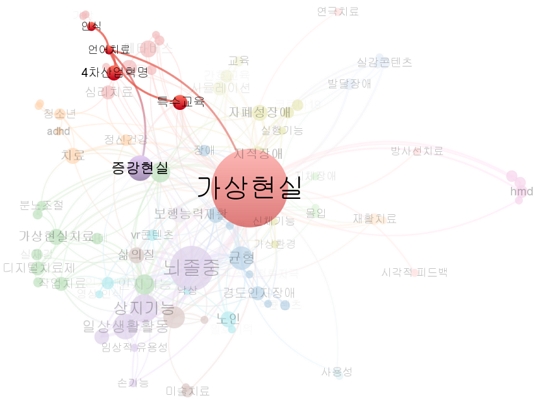
가상현실 언어치료의 전망: 계량서지학적 연구 동향 분석
Copyright 2024 ⓒ Korean Speech-Language & Hearing Association.
This is an Open-Access article distributed under the terms of the Creative Commons Attribution Non-Commercial License (http://creativecommons.org/licenses/by-nc/4.0) which permits unrestricted non-commercial use, distribution, and reproduction in any medium, provided the original work is properly cited.
초록
본 연구는 재활과 관련된 치료 분야에서 가상현실을 적용한 대량의 연구 문헌 자료들을 계량서지학적으로 분석하여 언어치료를 위한 가상현실의 타당성과 유용성을 알아보고 향후 가상현실 언어치료를 위한 지침을 제공하는 데 연구 목적을 두고 있다.
Web of Science(WoS)와 한국학술지인용색인(KCI) 데이터베이스에서 각각 추출한 37,522건과 5,040건의 연구 문헌들의 서지정보를, VOSviewer를 이용하여 계량서지학적으로 분석하였다. WoS와 KCI의 제목, 키워드 초록에 ‘virtual reality’ 또는 ‘virtual-reality’를 포함하는 학술논문을 검색하였다. 재활영역과 관련된 서지정보는 국외는 카테고리 옵션을 ‘Rehabilitation’으로 한정하여 검색하였고, 국내는 ‘재활’ 또는 ‘중재’ 또는 ‘치료’ 키워드로 검색하여 각각 1,336건과 340건의 서지정보를 얻었다. 수집된 서지정보는 VOSviewer를 이용하여 키워드 동시-출현빈도를 분석하고 시각화하였다.
국외 VR 연구 중 재활 관련 키워드는 ‘virtual reality’, ‘rehabilitation’, ‘stroke’, ‘balance’, ‘upper-limb’, ‘exercise’의 순이었고, 국내는 ‘가상현실’, ‘뇌졸중’, ‘상지기능’, ‘일상생활훈련’, ‘증강현실’, ‘균형’, ‘우울증’, ‘인지기능’, ‘게임’, ‘중재’ 순으로 출현빈도가 높게 나타났다. 국외와 국내 모두 VR 관련 연구가 증가 추세를 보였다. 국외의 VR 연구 중에서는 교육과 재활에 관한 연구가 비중을 많이 차지하였다. 국내, 국외 모두 재활 관련 VR 연구 중에서 언어재활에 관한 연구는 다른 재활영역에 비하여 상대적으로 적었다.
앞으로 VR 기술은 시대의 흐름에 맞게 언어치료 분야와 더욱 통합될 것이고 관련 연구는 더욱 풍부해지고 향상될 것이다. 향후, 언어치료를 위한 전용 VR 앱이 개발되고 효과가 검증되어야 할 것이다.
Abstract
The purpose of this study is to examine the validity and usefulness of virtual reality (VR) for speech therapy by bibliometrically analyzing a large body of research literature on the application of VR in rehabilitation-related treatment fields. Additionally, it aims to provide guidelines for future VR speech therapy.
The bibliographic information of 37,522 and 5,040 articles extracted from Web of Science (WoS) and Korea Citation Index (KCI) databases, respectively, was bibliometrically analyzed using VOSviewer. We searched WoS and KCI for articles containing ‘virtual reality’ or ‘virtual-reality’ in the title, keywords, and abstract. For rehabilitation, international sources were searched with the category option ‘rehabilitation,’ while domestic sources were searched using keywords such as ‘rehabilitation’ or ‘intervention’ or ‘therapy,’ resulting in 1,336 and 340 bibliographic records, respectively. The collected bibliographic information was analyzed and visualized for keyword co-occurrence frequency using VOSviewer.
In international VR research related to rehabilitation, the keywords ‘VR,’ ‘rehabilitation,’ ‘stroke,’ ‘balance,’ and ‘upper-limb’ appeared with the highest frequency. In Korea, the most frequent keywords were ‘VR,’ ‘stroke,’ ‘upper-limb function,’ ‘ADL,’ ‘AR,’ ‘balance,’ and ‘depression,’ in that order. Both international and domestic VR-related research showed an increasing trend. In international research, studies on education and rehabilitation accounted for a large portion. Both domestically and internationally, research on VR related to language rehabilitation was relatively scarce compared to other rehabilitation domains.
In the future, VR will be more integrated with speech therapy areas, following current trends, related research will be more abundant and enhanced. Subsequently, dedicated VR apps for speech therapy will need to be developed and their effectiveness verified.
Keywords:
Virtual reality, speech therapy, bibliometric, VOSviewer, keyword network analysis키워드:
가상현실, 언어치료, 계량서지학, 키워드 네트워크 분석Ⅰ. 서론
가상현실(virtual reality: VR)은 의료 훈련 시뮬레이션(Brunner et al., 2016; Kim et al., 2005), 치료(Carragher et al., 2021; Kim & Park, 2013; Marshall et al., 2018, 2020), 교육(Lorenzo et al., 2013; Strickland et al., 1996) 및 여러 분야의 훈련(Kelly et al., 2023; Park & Ma, 2022)을 위한 몰입형 플랫폼(immersive platform)을 제공한다. VR은 사용자의 여러 감각 양상을 통해 대상자가 외부 자극의 방해에서 벗어나서 실시간으로 가상 개체와 상호작용할 수 있는 환경을 제공한다.
VR은 비몰입형 데스크톱 디스플레이부터 몰입형 머리 장착형 디스플레이(head mounted display: HMD)까지 다양하게 나눌 수 있는데, 최근 출시된 대표적인 제품으로는 HMD를 이용한 몰입형 혼합현실(mixed reality: MR) 기기인 메타 퀘스트 3(Meta Quest 3, Meta Platforms, Inc., 2023)과 애플사의 비전 프로(Vision Pro, Apple, 2024)가 있다. 몰입형 VR 시스템은 실제 환경에서의 시각 및 청각 입력을 배제하도록 설계된 HMD를 통해서 다중 감각 피드백을 제공하고 동작 감지 기능을 통합하여 사용자가 반응형 가상 세계와 상호작용을 할 수 있도록 해준다(Bryant et al., 2019).
또한 VR은 상호작용 방식에 따라 가상환경에서 사전에 계획된 프로그램과 상호작용하는 1인 가상환경(single-user virtual environment: SVE)과 한 명 이상과 동시에 상호작용을 하는 다중 사용자 가상환경(multi-user virtual environments: MUVE)으로 나눌 수 있다(Packman & Meredith, 2011; Rutten et al., 2003). 두 유형 모두에서 자신의 아바타를 가상환경에서 독립적으로 제어하고, 음성, 움직임, 몸짓 등을 통해 프로그램이나 사용자와 직접 소통하게 된다(Rutten et al., 2003). 특히, 다중 사용자 인터페이스인 MUVE 방식의 VR은 SNS와 결합하여 메타버스와 같은 복잡한 소셜 VR 플랫폼을 제공한다. 소셜 VR 플랫폼은 여러 사용자가 방문하고 이동할 수 있는 가상환경을 제공하며, 다른 사람을 만나 상호작용하고 소통할 수 있는 공공 공간 역할을 한다(Maloney et al., 2021). 최신 HMD의 등장, 정교한 그래픽 기술과 실제 현실 같은 상호작용(interaction) 기술 등의 발전으로 VR은 사용자에게 가상공간 속에 살고 있는 듯한 느낌(Witmer & Singer, 1998)인 실재감(presence)을 선사한다.
여러 문헌에서 VR의 장점으로 몰입감(Bryant et al., 2019; Cho, 2020; Hong & Park, 2022), 반복(Snider et al., 2010), 상호작용(Bryant, et al., 2019; Kandalaft et al., 2013), 시ㆍ공간의 한계 극복(Park, 2022; Son, 2018), 실제 환경으로의 전이 용이, 안전(Son, 2018), 자극 통제(Son, 2018), 즉각적인 강화, 치료 인력 대체, 흥미를 통한 참여동기 유발(Marshall et al., 2016), 실재감(Cho, 2020) 등을 들고 있다.
1989년 Lanier(Whole Earth Review, 1989)가 VR이란 용어를 처음으로 대중화시킨 이후, VR이 가진 많은 장점과 적용 가능성에도 불구하고 1990년 이후에야 재활 치료 분야에서 주목받기 시작하였다. 1990년대 후반부터 가상현실을 인지장애 진단과 치료에 이용하려는 시도가 있었다(Grealy et al., 1999). 특히 물리치료(Snider et al., 2010), 작업치료, 인지치료(Manera et al., 2016; Manivannan et al., 2018) 등의 재활 치료 분야에서 몰입형 VR 응용프로그램들을 이미 사용해 왔다. Kim 등(2005)은 노인에게 VR을 이용한 인지기능 훈련에서 주의력과 즉각 및 지연 언어 기억력에서 향상이 있었다고 보고한 바 있다.
특수교육 분야에서도 자폐스펙트럼장애(autistic spectrum disorders: ASD) 아동을 대상으로 사회적 기술(Cheng & Ye, 2010; Cheng et al., 2010; Parsons et al., 2006; Smith et al., 2014), 감정 인식(Cheng et al., 2010; Moore et al., 2005), 동기 유발(Cheng & Ye, 2010; Parsons et al., 2006; Smith et al., 2014) 등에 효과가 있었다는 보고가 있다.
심리치료 분야에서는 가상현실 노출 치료(virtual reality exposure therapy: VRET) 응용프로그램을 통해 특정 공포증과 같은 인지 과정 손상 치료에 널리 사용해 왔다. 몰입형 VR을 사용하면 노출 치료를 통해 심각한 불안 반응을 줄일 수 있다(Krijn et al., 2004). 가상현실에서의 체계적 접근은 거미공포증, 고소공포증을 비롯하여 많은 공포증 치료(Reger et al., 2011)와 외상 후 스트레스 장애 치료(Arnfred et al., 2019)에 시도되고 있다.
언어치료 분야에서도 VR을 사용하는 일이 늘어나고 있다(Bryant et al., 2019). 의학이나 간호와 같은 다른 보건 분야에서는 학생들에게 임상 기술을 가르치기 위해 VR을 사용하는 연구들이 있었지만(Foronda et al., 2014; Maicher et al., 2017), 언어치료에서 VR의 사용은 주로 대상자 중재에 중점을 두었다(Kelly et al., 2023). Kelly 등(2023)은 언어치료학과 학생들을 대상으로 VR을 사용하여 임상 기술을 교육한 후 인식도를 조사하였는데 긍정적인 학습 경험을 창출했다고 강조하였다.
언어중재에서의 VR은 과업의 복잡성을 조작할 수 있고, 치료 환경과는 다른 실제 상황에서의 의사소통을 평가하는 등 기존 평가 및 치료 방법에 비해 이점이 있다(Brundage et al., 2006; Garcia et al., 2007; Stendal & Balandin, 2015). 의사소통장애가 있는 사람들은 실제 대화 및 의사소통 과업 중에 스트레스나 당혹감을 경험할 수 있다. VR은 사용자가 상대와 직접 대면하지 않고도 통제되고 시뮬레이션 된 안전한 환경 속에서 사회적, 기능적 의사소통 기술을 반복적으로 배우고 연습할 수 있도록 해준다(Kandalaft et al., 2013; Manivannan et al., 2018, Rutten et al., 2003). 이러한 이유로 VR은 의사소통을 위한 안정적이고 안전한 환경을 제공하여 부정적인 감정을 줄이는 데 도움이 될 수 있다(Brundage et al., 2006; Danilovic, 2009). 사회적 상호작용을 장려하고 의사소통장애인에게 원격치료를 제공하기 위해 개발된 가상환경인 Second Life(Linden Research, Inc., 2003)와 EVA Park(University of London, 2018)와 같은 프로그램을 통한 비몰입형 VR 사용이 몇 년 동안 언어병리학에서 증가하였다. Marshall 등(2016)은 EVA Park라는 가상 세계에서 5주 동안 20명의 실어증 환자에게 언어 자극을 제공한 결과, 의미 있는 결과를 얻었다. Kandalaft 등(2013)은 Second Life 내의 전용 가상 섬에서 8명의 자폐증 성인에게 사회 인지 훈련을 적용하여 마음이론과 감정 인식에서 향상이 있음을 보고하였다. Walkom(2016)은 말더듬인(person who stutters: PWS)을 대상으로 VR을 적용하였는데 4명 중 2명에게 불안이 줄어들었고 구어 유창성이 향상되었다.
국내ㆍ외에서 가상현실에 관한 연구가 방대하게 이루어져 왔으나, 언어재활 분야에서 문헌들을 모아서 연구 동향을 살펴본 연구는 부족한 실정이다. 몇몇 체계적 고찰 연구가 진행되었으나, 요약된 결과만을 보여준다는 제한점이 있다(Kim & Ahn, 2015). 최근에는 이를 보완하기 위해서 서지정보를 사용하여 학술 문헌과 같은 대량의 연구 정보들의 특성을 정량적으로 분석하는 계량서지학적 분석(bibliometric analysis)이 사용되고 있다. 계량서지학적 분석을 통해서 대량의 서지정보 데이터를 정량적으로 분석하여 주요 연구 영역과 핵심 연구물을 파악하고 연구의 흐름을 식별하는 데 도움을 얻을 수 있다(Donthu et al., 2021; Van Eck & Waltman, 2010).
따라서 본 연구에서는 재활과 관련된 치료 분야에서 가상현실을 적용한 대량의 연구 문헌 자료들을 계량서지학적으로 분석하여 언어치료를 위한 가상현실의 타당성과 유용성을 알아보고 향후 가상현실 언어치료를 위한 전망과 지침을 제공하는 데 연구 목적을 두고 있다.
Ⅱ. 연구 방법
1. 연구 대상 및 자료 수집 방법
본 연구에서는 언어재활 분야에서의 VR을 적용한 연구들의 동향을 파악하기 위하여 국외 문헌은 Web of Science(WoS) 학술 정보 데이터베이스를, 국내 문헌은 한국학술지인용색인(Korea Citation Index: KCI) 데이터베이스를 이용하여 서지정보를 각각 수집하였다. WoS는 세계적으로 가장 신뢰받는 학술 정보 데이터베이스로서 계량서지학적 연구에서 흔히 이용되고 있다(Li et al., 2023). 보다 우수한 논문들을 검색하기 위해서 검색 데이터베이스 자료를 SCIE(Science Citation Index Expanded), SSCI(Social Sciences Citation Index), ESCI(Emerging Sources Citation Index), A&HCI(Arts & Humanities Citation Index)로 한정하였고 문헌의 유형은 학술논문(article)으로, 언어는 영어로 제한하였다. 문헌의 제목, 키워드, 초록에 ‘virtual reality’ 또는 ‘virtual-reality’를 포함하는 문헌들의 서지정보를 추출하기 위해 검색 옵션을 ‘Topic’으로 설정하였다. 검색 결과 37,522편의 논문 서지정보가 추출되었다. 이 중에서 재활 분야의 VR 연구 동향을 살펴보기 위한 목적으로 WoS의 검색 결과분석에서 카테고리를 ‘Rehabilitation’으로 선택하여 재활과 관련된 1,336편의 서지정보를 별도로 추출하였다(Figure 1).
VR과 관련된 국내 연구 문헌의 서지정보를 수집하기 위해서 KCI 데이터베이스에서 등재지 이상의 학술지 논문을 대상으로 제목, 키워드, 초록에서 ‘가상현실’ 또는 ‘가상현실’을 포함하는 5,040편의 논문 서지정보를 추출하였다. 이 중에서 재활 분야의 VR 연구 동향을 파악하기 위한 목적으로 제목, 키워드, 초록에 ‘재활’ 또는 ‘중재’ 또는 ‘치료’를 함께 포함하고 있는 것들을 별도로 검색하여 340편의 논문 서지정보를 추출하였다.
2. 계량서지학적 분석
분석을 위한 국외 자료는 WoS 데이터베이스에서 최종적으로 선택된 문헌들의 서지정보를 텍스트 형식(.txt)으로 추출한 것이었으며, 국내 자료는 KCI 데이터베이스에서 최종 선택된 서지정보를 연구 정보 시스템 인용 파일 형식(.ris)으로 추출한 것이었다. 이렇게 추출된 서지정보 파일에 포함된 키워드 간의 네트워크를 분석하기 위해서 레이던(Leiden) 대학 과학기술연구센터(Centre for Science and Technology Studies)의 Van Eck와 Waltman이 계량서지 네트워크를 구축하고 시각화하기 위한 목적으로 개발한 텍스트 마이닝(text mining) 프로그램인 VOSviewer(version 1.6.20, CWTS, Netherlands, 2023)를 이용하였다. VOSviewer를 이용한 키워드 네트워크 분석에는 전체계수(full counting)와 분수계수(fractional counting) 방식이 있다. 전체계수란 연결 생성을 위한 행위가 발생했을 때 행위의 수를 모두 계수하는 방식이고, 분수계수란 가중치를 조정하여 계수하는 방식이다. 본 연구에서는 전체계수 방식을 채택하였고, 유사어목록(thesaurus) 파일을 사용하여 의미가 같지만 다르게 표현된 키워드들을 하나로 표준화하였다. 예컨대, ‘가상 현실’, ‘가상현실(vr)’, ‘virtual reality(가상현실)’, ‘vr(가상현실)’을 ‘가상현실’로 통일하였다. 키워드 네트워크 분석을 위해 본 연구자가 동시 출현빈도의 역치를 조정하여 네트워크 시각화 맵에 표시될 키워드를 선택하였다. 선택된 각 키워드는 분석 단위인 노드(node)에 해당한다. 표시된 네트워크 맵의 연결 관계와 가독성을 높이기 위해 키워드 출현빈도와 개수를 설정하고 시각화 크기(visualization size), 라벨 크기 변화율(labels size variation)을 적절히 조정하였다. 분석된 값은 map.txt 파일을 통해, id, label(키워드), weight<links>(노드의 연결 개수), weight<total link strength>(타 노드와 연결 값의 총합), weight<occurrences>(노드의 출현빈도), score<Avg. pub. year>(노드의 평균 출판 연도)를 얻을 수 있는데, 본 연구에서는 <total link strength>, <occurrences>, <Avg. pub. year>값을 활용하여 분석하였다.
Ⅲ. 연구 결과
1. 국외의 가상현실 관련 키워드 네트워크 분석
1987년부터 2024년까지 WoS 데이터베이스의 VR 연구 논문 수의 연도별 분포를 Figure 2에 제시하였다. VR에 관한 연구 논문의 수는 1987년에 게재된 1편을 시작으로 2019년 2,853편을 기점으로 급격히 증가하였다. 그래프의 추이를 살펴보면 관련 연구가 지속적으로 증가할 것으로 예측해 볼 수 있다.
추출된 서지정보들을 VOSviewer를 이용하여 키워드 네트워크를 분석한 결과를 Figure 3에 제시하였다. 분석 방법은 동시출현빈도(co-occurrence), 계수 방법은 전체계수, 분석 단위는 모든 키워드(all keyword)로 설정하였다. 연구자가 작성한 유사어목록 파일을 적용하여, 키워드의 출현빈도가 300회 이상 출현한 101개의 키워드를 대상으로 분석하였다. 동일한 의미인 예컨대, ‘virtual reality’, ‘virtual-reality’, ‘virtual-reality system’, ‘vr’ 등을 모두 ‘virtual reality’라는 통일된 단어로 합산하여 계수하도록 유사어목록 파일을 작성하여 분석에 사용하였다. 시각화 옵션에서 전체 패널 상의 노드 크기값(visualization size)은 2.00으로, 노드 모양의 크기 변화율(labels size variation)은 .50으로 설정하였다.
출현빈도가 높은 키워드일수록 노드(원)의 크기가 크며, 연관성이 높을수록 노드 사이의 거리가 가깝고, 노드 간 연결고리도 많이 나타나게 된다. VOSviewer에서 보여주는 맵은 단순하게 노드 사이의 연관성만을 보여주는 것이 아니라, 서로 다른 색으로 그룹화하여 클러스터를 확인할 수 있도록 시각화해 준다. 키워드 네트워크 분석에서 클러스터의 색깔이 같다면, 문헌에서 동시 출현 가능성이 크고, 연관 관계가 높으며, 같은 연구 주제에 해당하는 키워드임을 의미한다.
분석 결과, 총 5개의 클러스터가 만들어졌고, 클러스터 1은 빨간색으로 VR의 특징, 클러스터 2는 초록색으로 심리치료, 클러스터 3은 파란색으로 재활, 클러스터 4는 노란색으로 VR 기술, 클러스터 5는 보라색으로 교육에 대한 키워드로 이루어져 있다. 출현빈도가 높은 상위 10개의 클러스터별 키워드를 Table 1에 제시하였다. 가장 최근에 출현한 상위 3개의 키워드는 ‘metaverse(평균 2022.8년)’, ‘covid-19(평균 2021.8년)’, ‘engagement(평균 2021.1년)’이며, 가장 오래된 하위 3개의 키워드는 ‘operating-room(평균 2013.2년)’, ‘acquisition(평균 2014.7년)’, ‘simulator(평균 2014.8년)’이었다.
출현빈도가 높은 상위 101개의 키워드에 ‘speech’와 ‘language’는 포함되지 않았으며, ‘communication’의 키워드가 클러스터 4에 포함되어 있었으나 언어치료와 관련 있는 것이 아니라 VR 기술에 대한 설명과 관련된 것이었다.
VR에 대한 논문이 급격하게 증가한 2019년을 기준으로 2019년 이전과 2020년 이후를 비교해 보았다(Figure 4, 5).
2019년 이전까지는 총 4개의 클러스터가 만들어졌다. 클러스터 1은 VR의 특징(‘virtual reality(7,906회)’, ‘augmented reality(1,034회)’, ‘environment(934회)’, ‘reality(909회)’, ‘system(733회)’, ‘perception(647회)’, ‘design(604회)’, ‘virtual environment(490회)’, ‘experience(412회)’, ‘navigation(385회)’ 등), 클러스터 2는 재활(‘rehabilitation(887회)’, ‘stroke(698회)’, ‘exposure therapy(516회)’, ‘games(497회)’, ‘children(449회)’, ‘anxiety(445회)’, ‘technology(437회)’, ‘therapy(388회)’, ‘balance(330회)’ 등), 클러스터 3은 교육(‘simulation(1,619회)’, ‘performance(1,356회)’, ‘education(933회)’, ‘validity(748회)’, ‘surgery(700회)’, ‘training(577회)’, ‘skills(574회)’, ‘impact(351회)’, ‘operation-room(305회)’, ‘simulator(300회)’ 등), 클러스터 4는 VR 기술(‘feedback(242회)’, ‘haptic(171)’, ‘students(155회)’)이었다. 반면, 2020년 이후에는 클러스터 1은 교육(‘virtual reality(11,007회)’, augmented reality(2,245회), education(1,388회), simulation(1,157회) 등), 클러스터 2는 재활(rehabilitation(826회), games(807회), anxiety(712회), children(687회) 등), 클러스터 3은 VR의 특징(performance(1,143회), environments(1,097회), reality(858회), perception(826회) 등)으로 총 3개의 클러스터가 만들어졌다.
재활과 관련된 VR 연구들을 좀 더 세부적으로 알아보기 위하여 WoS 검색 결과분석에서 카테고리를 ‘Rehabilitation’으로 선택하여 추출된 1,336편의 논문을 분석하였다(Figure 6, 7, Table 2). 분석 방법과 유사어목록 파일은 WoS 분석과 동일하였고, 키워드의 출현빈도가 28회 이상 등장한 77개의 키워드를 대상으로 분석하였다.
클러스터 1은 빨간색으로 작업치료, 클러스터 2는 초록색으로 심리치료, 클러스터 3은 파란색으로 물리치료, 클러스터 4는 노란색으로 인지치료와 관련된 키워드로 구성되었다. 재활과 관련된 연구 중 가장 최근에 출현한 상위 3개의 키워드는 ‘autism(평균 2020.4년)’, ‘augmented reality(평균 2019.9년)’, ‘intervention(평균 2019.3년)’이며, 가장 오래된 하위 3개의 키워드는 ‘brain-injury(평균 2012.9년)’, ‘cognitive rehabilitation(평균 2012.9년)’, ‘induced movement therapy(평균 2014.1년)’이었다.
2. 국내의 가상현실 관련 키워드 네트워크 분석
KCI 데이터베이스에서 검색된 VR 연구 논문을 2002년부터 2024년까지 연도별 논문 수 분포를 Figure 8에 제시하였다. 국외 연구와 마찬가지로 지속적인 증가 추세를 보였다.
이를 VOSviewer를 이용하여 키워드 네트워크 분석한 결과를 Figure 9에 제시하였다. 유사어목록 파일은 연구자가 한글 키워드를 바탕으로 새로 작성하였고, 분석 방법은 이전과 동일하였으며, 키워드의 출현빈도가 13회 이상 등장한 77개의 키워드를 대상으로 분석하였다.
분석 결과 87개의 키워드는 9개의 클러스터, 1,302개의 연결 수, 5,752개의 연결 강도를 만들었다. VR 관련 KCI 데이터베이스의 한글 키워드는 총 9개의 클러스터가 만들어졌다. 클러스터 1은 빨간색으로 ‘시뮬레이션, ‘게임(111회)’, ‘가상공간(89회)’, ‘스포츠(74회)’, ‘가상(37회)’, ‘융합(29회)’, ‘가상성(27회)’, ‘체험(26회)’, ‘실제(23회)’, ‘재현(23회)’, 클러스터 2는 녹색으로 ‘실재감(130회), ‘상호작용(107회)’, ‘몰입(56회)’, ‘스토리텔링(46회)’, ‘애니메이션(40회)’, ‘사용자경험(28회)’, ‘미디어(21회)’, ‘VR 콘텐츠(19회)’, ‘영화(18회)’, 클러스터 3은 파란색으로 ‘가상현실(1,729회)’, ‘콘텐츠(83회)’, ‘실감 콘텐츠(51회)’, ‘디지털트윈(44회)’, ‘몰입감(34회)’, ‘가상환경(32회)’, ‘확장현실(27회)’, ‘딥러닝(24회)’, ‘사이버 멀미(24회)’, ‘에듀테크(23회)’, 클러스터 4는 노란색으로 ‘4차 산업혁명(112회)’, ‘인공지능(104회)’, ‘HMD(66회)’, ‘인터페이스(43회)’, ‘플랫폼(24회)’, ‘사물인터넷(22회)’, ‘사용성(18회)’, ‘뉴미디어(16회)’, ‘모바일(15회)’, 클러스터 5는 보라색으로 ‘메타버스(405회)’, ‘가상 세계(57회)’, ‘아바타(44회)’, ‘가상자산(40회)’, ‘가상화폐(29회)’, ‘코로나19(29회)’, ‘제페토(147회)’, ‘저작권(14회)’, 클러스터 6은 하늘색으로 ‘뇌졸중(68회)’, ‘균형(28회)’, ‘상지 기능(27회)’, ‘우울증(23회)’, ‘일상생활활동(22회)’, ‘인지기능(16회)’, ‘노인(13회)’, 클러스터 7은 ‘증강현실(479회)’, ‘혼합현실(82회)’, ‘시뮬레이터(15회)’, ‘유니티(14회)’, 클러스터 8은 ‘교육(45회)’, ‘간호교육(44회)’, 클러스터 9는 ‘시각화(18회)’의 순으로 출현빈도가 나타났다.
VR과 관련하여 가장 최근에 출현된 상위 3개의 키워드는 ‘메타버스’(평균 2022.2년), ‘확장현실’(평균 2022.0년), ‘가상자산’(평균 2022.0년)이며, 가장 오래된 하위 3개의 키워드는 ‘디지털’(평균 2013.7년), ‘모바일’(평균 2014.1년), ‘실제’(평균 2014.4년)이었다.
VR에서 재활이 차지하는 비중을 좀 더 알아보기 위하여 ‘재활’ 또는 ‘중재’ 또는 ‘치료’를 반드시 포함하고 있는 340편의 논문을 분석하였다(Figure 10, 11, Table 3). 국내 VR 관련 연구 전체와 마찬가지로 재활영역에서도 증가 추세를 보였는데 2020년에 가장 많은 연구(48편)가 발표되었다.
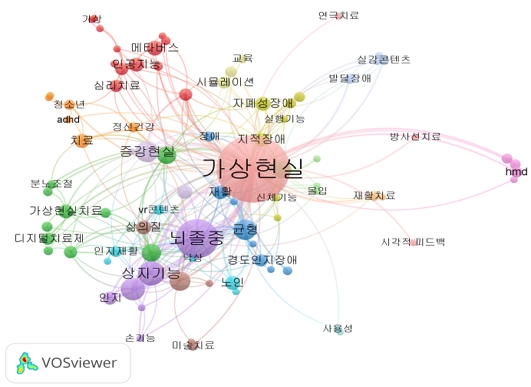
Map based on KCI VR article’s bibiliographic data related rehabilitation or intervention or therapy with VOSviewer

Cluster of keywords and total link strength, occurrences, average publication year (KCI data related rehabilitation or intervention or therapy)
국내 재활과 관련된 VR 연구에 관한 분석 방법과 유사어목록 파일은 국내 VR 관련 전체 연구 분석과 동일하였는데, 키워드의 출현빈도가 2회 이상 등장한 87개의 키워드를 대상으로 분석하였다.
87개의 키워드 간의 연결 강도를 통한 네트워크를 분석한 결과, 16개의 클러스터, 556개의 연결 수, 1,184개의 연결 강도가 생성되었다.
Figure 12는 재활 관련 논문 340편의 출판연도 평균을 분석하여 각 클러스터에 대한 색상을 막대로 표시한 것이다. 밝은 노란색에 가까울수록 최근에 등장한 키워드를 의미하며 어두운 파란색으로 갈수록 과거에 등장했던 키워드를 의미한다. 2016년에는 ‘노인’, ‘재활’, ‘HMD’ 등의 키워드가 출현하였으나, 2018년에는 ‘가상현실’, ‘상지기능’, ‘가상현실치료’, ‘자폐성장애’, ‘경도인지장애’ 등, 2020년에는 ‘인지기능’, ‘삶의 질’, ‘지적장애’, ‘4차 산업혁명’, ‘인지재활’ 등, 2022년에는 ‘메타버스’, ‘디지털치료제’, ‘혼합현실’ 등이 주요 키워드로 출현하였다.
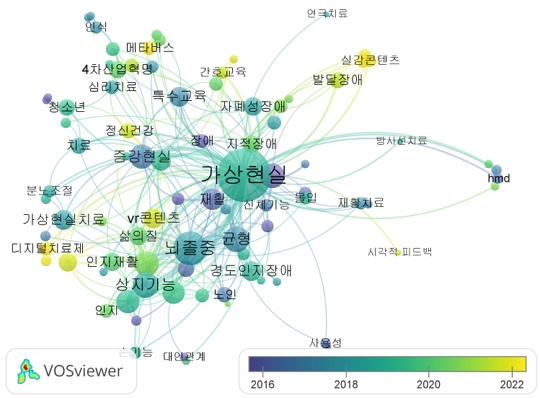
Overlay visualization based on KCI VR article’s bibiliographic data related rehabilitation or intervention or therapy
언어치료 키워드는 Figure 13과 같이 출현빈도가, 다른 재활 및 치료 영역에 비하여 2회로 매우 낮았다. 다른 키워드에 비하여 노드의 크기가 작은 것은 출현빈도가 낮기 때문이다. 노드 간 연결선의 수가 작고 ‘가상현실’ 노드와 거리가 먼 것은 연관성이 낮다는 것을 의미한다. ‘가상현실’이라는 키워드보다는 ‘4차 산업혁명’, ‘증강현실’ 키워드와 연관성이 높게 나타난 것은 언어치료 영역에서 VR 연구가 활성화되지 않았음을 의미한다.
가장 최근에 출현한 상위 3개의 키워드는 ‘디지털치료제’(평균 2022.7년), ‘혼합현실’(평균 2022.7년), ‘실감콘텐츠’(2022.1년)이었고, 가장 오래된 하위 3개의 키워드는 ‘보행능력’(평균 2012.6년), ‘정서’(평균 2014.5년), ‘가상환경’(평균 2015.5년)이었다. ‘언어치료’ 키워드의 평균 출현 연도는 2019.5년으로 다른 재활영역에 비하여 비교적 최근에 출현하였다.
Ⅳ. 논의 및 결론
본 연구에서 언어치료를 위한 가상현실의 전망을 알아보고 향후 가상현실 언어치료 분야의 연구 활성화에 기여하기 위하여, WoS와 KCI 데이터베이스에서 각각 추출한 37,522건과 5,040건의 VR 연구 문헌들의 서지정보를, VOSviewer를 이용하여 계량서지학적으로 분석하였다. 키워드 네트워크 분석 결과가 시사하는 바는 다음과 같다.
첫째, 국외의 VR에 관한 연구는 2019년(2,853편)을 기점으로 급격히 증가하였으며, 재활 관련 논문도 매년 100편 이상 발표되어 왔다. 분석 대상 논문 중 키워드의 출현빈도가 높은 상위 101개의 키워드를 추출하여 키워드 네트워크를 분석한 결과 ‘virtual reality(18,913회)’, ‘augmented reality(3,279회)’, ‘simulation(2,776회)’, ‘performance(2,499회)’, ‘education(2,321회)’, ‘environments(2,031회)’, ‘reality(1,767회)’, ‘rehabilitation(1,713회)’이 고빈도 키워드로 출현하였다. 이는 VR에 관한 연구 중에 교육과 재활에 관한 연구가 비중을 크게 차지함을 알 수 있다. 하지만, ‘speech’와 ‘language’는 상위 101개의 키워드에서 포함되지 않았다. VR가 관계된 WoS의 37,522건의 서지정보 중에서 카테고리 옵션을 Rehabilitation으로 한정하여 재검색한 1,336건의 서지정보에서 출현빈도가 28회 이상인 77개의 키워드를 분석하였다. Rehabilitation 카테고리에서는 ‘virtual reality(937회)’, ‘rehabilitation(597회)’, ‘stroke(465회)’, ‘balance(204회)’, ‘upper-limb(200회)’, ‘exercise(177회)’가 출현빈도가 높게 나왔다. ‘speech’와 ‘language’는 이 키워드에 포함되지 않았다. 그에 비해, ‘exposure therapy(52회)’, ‘physical therapy(44회)’, ‘occupational therapy(33회)’, ‘cognitive rehabilitation(32회)’이 고빈도 키워드로 출현하였다. 이는 재활 관련 VR 연구 중에서 언어재활에 관련된 연구는 다른 재활영역에 비해 상대적으로 드물다는 사실을 시사해 준다.
둘째, 국내의 VR에 관한 연구는 총 5,040편으로 2009년(131편)을 기점으로 증가하다가 2019년부터는 매년 400~600편 이상의 논문이 발표되어왔다. 분석 대상 논문 중 키워드의 출현빈도가 높은 순으로 상위 77개의 키워드를 추출하여 키워드 네트워크를 분석한 결과 ‘가상현실(1,729회)’, ‘증강현실(479회)’, ‘메타버스(405회)’, ‘실재감(130회)’, ‘4차 산업혁명(112회)’, ‘시뮬레이션(111회)’, ‘상호작용(107회)’, ‘인공지능(104회)’이 고빈도 키워드로 출현하였고, ‘뇌졸중(68회)’과 ‘교육(45회)’은 각각 상위 13위, 20위를 차지하였다. 재활이나 치료와 관련된 키워드 중 ‘뇌졸중’, ‘상지기능(37위)’, ‘우울증(44위)’, ‘일상생활훈련(47위)’ 등 재활 관련 키워드들도 출현하였다.
재활 관련 340편의 연구 중에서 출현빈도가 2회 이상 등장한 87개의 키워드는 ‘가상현실(180회)’, ‘뇌졸중(61회)’, ‘상지기능(24회)’, ‘일상생활훈련(20회)’, ‘증강현실(18회)’, ‘균형(17회)’, ‘우울증(15회)’, ‘인지기능(13회)’, ‘게임(12회)’, ‘중재(12회)’ 순으로 나타났다. 그 이외 키워드는 출현빈도가 10회 이하였다. ‘심리치료(6회)’, ‘작업치료(6회)’, ‘인지재활(5회)’, ‘노출치료(4회)’, ‘미술치료(4회)’, ‘인지행동치료(3회)’에 비해 ‘언어치료’ 키워드는 2회에 불과한 것으로 보아 국외와 마찬가지로 국내에서도 다른 재활영역에 비하여 언어치료에 관한 VR 연구가 저조함을 알 수 있다. ‘의사소통기술’이 키워드로 출현하였지만, 이것은 언어치료와 관련되었다기보다 ‘자폐성장애’, ‘지적장애’ 등과 관련된 것이었다.
계량서지학적 분석에서 도출되는 결과물 중 하나인 시각화된 네트워크 맵은 해당 학문 분야에서 다루는 다양한 영역을 분석하여 한눈에 파악할 수 있게 도와주기 때문에 ‘지식 지도(knowledge mapping)’라고도 부른다. 따라서, 계량서지학적 분석 방법은 언어치료 분야에서도 관심 있는 연구 분야의 동향을 파악하는 데 유용한 분석 방법론이 될 수 있다(Nam, 2022).
분석 결과에서 ‘노출치료(4회)’, ‘발표불안(4회)’, ‘실감콘텐츠(4회)’, ‘실재감(4회)’, ‘의사소통기술(4회)’이 키워드로 출현한 것으로 보아, VR의 특징인 ‘실재감’이 느껴지는 ‘실감콘텐츠’로 ‘발표불안’을 느끼고 있는 말더듬이에게 ‘노출치료’를 통해 ‘의사소통기술’을 가르치는 것은 VR을 이용한 훌륭한 접근법이 될 수 있음을 시사 받을 수 있다. 이미 Walkom(2016)이 말더듬이에게 VRET만을 사용하여 유창성이 향상되었다고 보고한 바가 있다. 이 연구자는 PWS에게 VR 헤드셋을 통해 가상 강의실 환경에서 청중 앞에서 특정 주제에 대해 5분간 이야기하도록 체계적으로 노출시켰는데 참가자들은 가상환경에서뿐만 아니라 실제 상황에서도 구어 유창성이 향상되었다. 또한, Brundage 등(2006)은 VR 사용이 PWS에게 언어치료 효과의 일반화에 도움이 된다고 주장하였다. deLeyer-Tiarks 등(2021)은 3명의 성인 말더듬이에게 360도 VR 비디오를 이용한 VR 자기 모델링(Virtual Reality Self-Modeling)을 실시하여 중증도가 임상적으로 유의하게 감소한 것을 보고하였다. 이 외에도 다수의 연구에서 VR은 PWS의 치료와 평가에 효과적이라고 보고된 바가 있다(Al-Nafjan et al., 2021; Brundage & Hancock, 2015; Brundage et al., 2016; Moïse-Richard et al., 2021).
VR을 이용하게 되면 의사소통 스트레스가 많은 환경을 효과적으로 재현하고, 안전하게 반복하는 것이 가능해진다. EVA Park, Second Life, VRChat(VRChat Inc., 2017)과 같은 소셜 VR 플랫폼을 통해 공간적 제약을 줄일 수 있다. 이러한 대규모 소셜 VR 플랫폼은 내부에 수많은 가상 월드들을 포함하고 있는데, 각 월드는 초대받은 사람만 들어갈 수 있도록 만들 수 있다. 이러한 월드는 쇼핑센터, 댄스홀, 심지어 교육기관까지 규모와 범위가 다양하다.
또한 VR에 머신러닝(machine learning)과 같은 인공지능 기술을 사용하면 기존 치료 전략에 비해 사용자 편의성과 비교적 저렴한 비용을 유지하면서 맞춤화 및 개별화된 치료 프로그램 제공이 가능해진다(LC & Fukuoka, 2019). SVE 프로그램이라면, ChatGPT와 같은 OpenAI에 TTS(text to speech)와 음성 인식 기능을 결합하여 현실 세계와 유사하게 대화형 질문이나 답변을 주고받을 수 있다. 웨어러블 기기의 센서를 이용한 신체 증후를 유창성장애 평가에 활용하여 불안이나 흥분 등의 감정 변화를 평가할 수도 있다.
가상현실을 이용한 유창성장애 치료의 예와 마찬가지로 다른 언어장애 영역에도 VR은 유용하게 사용될 수 있을 것으로 전망된다. 가상현실 언어치료는 지금까지 시행되어 온 고전적인 언어치료 방식의 단점과 제한점을 보완하고 치료의 효율성과 접근성을 높일 수 있을 것으로 기대된다. 이상의 결과를 종합해 볼 때, 선행 연구에서 효과가 입증되었듯이 기술의 발달과 더불어 언어치료와 평가에 VR을 접목한 연구가 점차 증가할 것으로 기대된다.
본 연구의 제한점과 향후 관련 분야 연구를 위한 지침을 제시하자면 다음과 같다.
첫째, 본 연구에서 VR 관련 연구 문헌을 객관적이고 종합적이며 체계적으로 분석하기 위해 VOSviewer를 이용하여 계량서지학적 분석을 하였는데, 이러한 계량서지학적 분석은 특정 연구 분야의 지식 기반(knowledge bases), 현재 화제가 되는 연구 주제(hot spots) 및 향후 동향을 파악할 수 있도록 도와준다(Fan et al., 2023). 계량서지학적 네트워크의 강점은 단순화이다. 하지만 단순화의 대가로 맥락, 정확도, 정보량의 손실이 발생할 수 있다. 이러한 제한점에도 불구하고 계량서지학적 분석은 연구자의 배경지식이나 선입견과 무관하게 만들어지기 때문에 기존 분석이 가지는 한계를 보완하고 연구의 흐름을 효과적으로 보여줄 수 있다. 2001년부터 2021년까지 Journal of Speech, Language, and Hearing Research(JSLHR)에서 발행된 논문을, VOSviewer를 이용하여 계량서지학적 고찰을 수행한 연구가 최근 미국언어청각협회(American Speech-Language-Hearing Association: ASHA)의 한 학술지에 게재된 바 있으나(Vitevitch, 2023), 국내에서는 본 연구가 VOSviewer를 이용한 계량서지학적 분석을 시도한 언어치료 분야의 첫 연구라는 데 그 의의가 있다.
둘째, 기술의 발달로 과거에 비해 성능이 우수한 VR 기기의 가격이 저렴해졌다. 예컨대 30만 원대의 메타 퀘스트 2와 60만 원대의 메타 퀘스트 3은 신형 핸드폰보다도 저렴하다. 퀘스트 2의 판매량이 1천만 대를 돌파하면서(ZDnet Korea, 2021) VR 기기가 빠르게 대중화되고 있다. 사람들이 VR 장비를 쉽게 접할 수 있게 되면서 피트니스, 스포츠, 게임 등 다양한 분야의 VR 앱에 흥미를 가지게 되었다. 앞으로 VR 기술은 시대의 흐름에 맞게 언어치료 분야와 더욱 통합되고 관련 연구가 보다 풍부해지고 향상될 것으로 전망된다. 언어장애인을 위한 VR 연구가 늘어나고 있지만(Al-Nafjan et al., 2021; Brundage et al., 2016; Bryant et al., 2024; Vaezipour et al., 2022), 치료 전용 몰입형 VR 앱은 개발이 저조한 편이다(Brassel et al., 2023). 현재는 기존에 개발된 VRChat과 같은 가상 월드를 이용한 치료가 가능하나 향후, 언어치료를 위한 전용 VR 앱 개발과 그 효과를 검증하는 연구가 지속적으로 진행될 필요가 있겠다.
References
-
Al-Nafjan, A., Alghamdi, N., & Almudhi, A. (2021). Virtual reality technology and speech analysis for people who stutter. EMITTER International Journal of Engineering Technology, 9(2), 326-338.
[https://doi.org/10.24003/emitter.v9i2.649]

-
Arnfred, B., Bang, P., Hjorthøj, C., Winding, C., Møller, K., Hvenegaard, M., . . . Nordentoft, M. (2019). Cognitive behavioural therapy augmented with virtual reality exposure for treatment of social anxiety: A randomised clinical trial.
[https://doi.org/10.21203/rs.2.504/v1]

-
Brassel, S., Brunner, M., Power, E., Campbell, A., & Togher, L. (2023). Speech-language pathologists’ views of using virtual reality for managing cognitive-communication disorders following traumatic brain injury. American Journal of Speech-Language Pathology, 32(2S), 907-923.
[https://doi.org/10.1044/2022_AJSLP-22-00077]

-
Brundage, S. B., & Hancock, A. B. (2015). Real enough: Using virtual public speaking environments to evoke feelings and behaviors targeted in stuttering assessment and treatment. American Journal of Speech-Language Pathology, 24(2), 139-149.
[https://doi.org/10.1044/2014_ajslp-14-0087]

-
Brundage, S. B., Brinton, J. M., & Hancock, A. B. (2016). Utility of virtual reality environments to examine physiological reactivity and subjective distress in adults who stutter. Journal of Fluency Disorders, 50, 85-95.
[https://doi.org/10.1016/j.jfludis.2016.10.001]

-
Brundage, S. B., Graap, K., Gibbons, K. F., Ferrer, M., & Brooks, J. (2006). Frequency of stuttering during challenging and supportive virtual reality job interviews. Journal of Fluency Disorders, 31(4), 325-339.
[https://doi.org/10.1016/j.jfludis.2006.08.003]

-
Brunner, I., Skouen, J. S., Hofstad, H., Aßmuss, J., Becker, F., Pallesen, H., . . . Verheyden, G. (2016). Is upper limb virtual reality training more intensive than conventional training for patients in the subacute phase after stroke? An analysis of treatment intensity and content. BMC Neurology, 16, 219.
[https://doi.org/10.1186/s12883-016-0740-y]

-
Bryant, L., Brunner, M., & Hemsley, B. (2019). A review of virtual reality technologies in the field of communication disability: Implications for practice and research. Disability and Rehabilitation: Assistive Technology, 15(4), 365-372.
[https://doi.org/10.1080/17483107.2018.1549276]

-
Bryant, L., Sedlarevic, N., Stubbs, P., Bailey, B., Nguyen, V., Bluff, A., . . . Hemsley, B. (2024). Collaborative co-design and evaluation of an immersive virtual reality application prototype for communication rehabilitation (DISCOVR prototype). Disability and Rehabilitation: Assistive Technology, 19(1), 90-99.
[https://doi.org/10.1080/17483107.2022.2063423]

-
Carragher, M., Steel, G., Talbot, R., Devane, N., Rose, M. L., & Marshall, J. (2021). Adapting therapy for a new world: Storytelling therapy in EVA Park. Aphasiology, 35(5), 704-729.
[https://doi.org/10.1080/02687038.2020.1812249]

-
Cheng, Y., & Ye, J. (2010) Exploring the social competence of students with autism spectrum conditions in a collaborative virtual learning environment: The pilot study. Computers & Education, 54(4), 1068-1077.
[https://doi.org/10.1016/j.compedu.2009.10.011]

-
Cheng, Y., Chiang, H.-C., Ye, J., & Cheng, L. (2010). Enhancing empathy instruction using a collaborative virtual learning environment for children with autistic spectrum conditions. Computers & Education, 55(4), 1449-1458.
[https://doi.org/10.1016/j.compedu.2010.06.008]

-
Cho, O. (2020). A study on the current situation and prospect of virtual reality as a psychological therapy system. Journal of the Future of Society, 20(11), 1-14.
[https://doi.org/10.22987/jifso.2020.11.1.1]

- Danilovic, S. (2009). Media review: Autism and second life—An introduction. Journal on Developmental Disabilities, 15(3), 125-129.
-
deLeyer-Tiarks, J. M., Bray, M. A., Chafouleas, S. M., Kaufman, J. C., & Li, M. G. (2021). Investigating virtual reality for the delivery of self-modeling interventions: Virtual reality self-modeling as an intervention for stuttering. Translational Issues in Psychological Science, 7(3), 271-283.
[https://doi.org/10.1037/tps0000294]

-
Donthu, N., Kumar, S., Mukherjee, D., Pandey, N., & Lim, W. M. (2021). How to conduct a bibliometric analysis: An overview and guidelines. Journal of Business Research, 133, 285-296.
[https://doi.org/10.1016/j.jbusres.2021.04.070]

-
Fan, T., Wang, X., Song, X., Zhao, G., & Zhang, Z. (2023). Research status and emerging trends in virtual reality rehabilitation: Bibliometric and knowledge graph study. JMIR Serious Games, 11, e41091.
[https://doi.org/10.2196/41091]

-
Foronda, C., Gattamorta, K., Snowden, K., & Bauman, E. B. (2014). Use of virtual clinical simulation to improve communication skills of baccalaureate nursing students: A pilot study. Nurse Education Today, 34(6), e53-e57.
[https://doi.org/10.1016/j.nedt.2013.10.007]

-
Garcia, L. J., Rebolledo, M., Metthé, L., & Lefebvre, R. (2007). The potential of virtual reality to assess functional communication in aphasia. Topics in Language Disorders, 27(3), 272-288.
[https://doi.org/10.1097/01.TLD.0000285360.18298.86]

-
Grealy, M. A., Johnson, D. A., & Rushton, S. K. (1999). Improving cognitive function after brain injury: the use of exercise and virtual reality. Archives of Physical Medicine and Rehabilitation, 80(6), 661-667.
[https://doi.org/10.1016/s0003-9993(99)90169-7]

-
Hong, S., & Park, H. (2022). Speech-language pathologist and preliminary speech-language pathologist on language therapy changes in the fourth industrial revolution. The Journal of Humanities and Social Sciences 21, 13(5), 549-561.
[https://doi.org/10.22143/HSS21.13.5.39]

-
Kandalaft, M. R., Didehbani, N., Krawczyk, D. C., Allen, T. T., & Chapman, S. B. (2013). Virtual reality social cognition training for young adults with high-functioning autism. Journal of Autism and Developmental Disorders, 43(1), 34-44.
[https://doi.org/10.1007/s10803-012-1544-6]

-
Kelly, B., Walters, J., & Unicomb, R. (2023). Speech pathology student perspectives on virtual reality to learn a clinical skill. Teaching and Learning in Communication Sciences & Disorders, 7(1), 5.
[https://doi.org/10.30707/TLCSD7.1.1675490380.832879]

-
Kim, D. Y., & Park, J. B. (2013). Virtual reality based stroke rehabilitation. Journal of the Korean Medical Association, 56(1), 16-22.
[https://doi.org/10.5124/jkma.2013.56.1.16]

-
Kim, H. J., & Ahn, H. S. (2015). Critical appraisal of systematic review/meta-analysis. The Korean Journal of Helicobacter and Upper Gastrointestinal Research, 15(2), 73-79.
[https://doi.org/10.7704/kjhugr.2015.15.2.73]

- Kim, M.-Y., Lee, K.-S., Choi, J.-S., Kim, H.-B., & Park, C.-I. (2005). Effectiveness of cognitive training based on virtual reality for the elderly. Annals of Rehabilitation Medicine, 29(4), 424-433. uci: G704-000430.2005.29.4.006
-
Krijn, M., Emmelkamp, P. M. G., Olafsson, R. P., & Biemond, R. (2004). Virtual reality exposure therapy of anxiety disorders: A review. Clinical Psychology Review, 24(3), 259-281.
[https://doi.org/10.1016/j.cpr.2004.04.001]

-
Lc, R., & Fukuoka, Y. (2019). Machine learning and therapeutic strategies in VR. Proceedings of the 9th International Conference on Digital and Interactive Arts, 42.
[https://doi.org/10.1145/3359852.3359908]

-
Li, D., Ou, J., Zeng, Y., Hou, L., Yuan, Y., & Luo, Z. (2023). Bibliometric study on clinical research of osteoporosis in adolescents. Frontiers in Public Health, 11, 1041360.
[https://doi.org/10.3389/fpubh.2023.1041360]

- Linden Research, Inc. (2003). Second Life [Software]. Retrieved from https://secondlife.com/
-
Lorenzo, G., Pomares, J., & Lledó, A. (2013). Inclusion of immersive virtual learning environments and visual control systems to support the learning of students with Asperger syndrome. Computers & Education, 62, 88-101.
[https://doi.org/10.1016/j.compedu.2012.10.028]

-
Maicher, K., Danforth, D., Price, A., Zimmerman, L., Wilcox, B., Liston, B., . . . Rizer, M. (2017). Developing a conversational virtual standardized patient to enable students to practice history-taking skills. Simulation in Healthcare, 12(2), 124-131.
[https://doi.org/10.1097/sih.0000000000000195]

-
Maloney, D., Freeman, G., & Robb, A. (2021). Social virtual reality: Ethical considerations and future directions for an emerging research space. Proceedings of 2021 IEEE Conference on Virtual Reality and 3D User Interfaces Abstracts and Workshops (VRW), 271-277.
[https://doi.org/10.1109/VRW52623.2021.00056]

-
Manera, V., Chapoulie, E., Bourgeois, J., Guerchouche, R., David, R., Ondrej, J., . . . Robert, P. (2016). A feasibility study with image-based rendered virtual reality in patients with mild cognitive impairment and dementia. PLoS ONE, 11(3), e0151487.
[https://doi.org/10.1371/journal.pone.0151487]

-
Manivannan, S., Al-Amri, M., Postans, M., Westacott, L. J., Gray, W., & Zaben, M. (2018). The effectiveness of virtual reality interventions for improvement of neurocognitive performance after traumatic brain injury: A systematic review. Journal of Head Trauma Rehabilitation, 34(2), E52-E65.
[https://doi.org/10.1097/HTR.0000000000000412]

-
Marshall, J., Booth, T., Devane, N., Galliers, J., Greenwood, H., Hilari, K., . . . Woolf, C. (2016). Evaluating the benefits of aphasia intervention delivered in virtual reality: Results of a quasi-randomised study. PLoS ONE, 11(8), e0160381.
[https://doi.org/10.1371/journal.pone.0160381]

-
Marshall, J., Devane, N., Edmonds, L., Talbot, R., Wilson, S., Woolf, C., & Zwart, N. (2018). Delivering word retrieval therapies for people with aphasia in a virtual communication environment. Aphasiology, 32(9), 1054-1074.
[https://doi.org/10.1080/02687038.2018.1488237]

-
Marshall, J., Devane, N., Talbot, R., Caute, A., Cruice, M., Hilari, K., . . . Wilson, S. (2020). A randomised trial of social support group intervention for people with aphasia: A Novel application of virtual reality. PLoS ONE, 15(9), e0239715.
[https://doi.org/10.1371/journal.pone.0239715]

-
Moïse-Richard, A., Ménard, L., Bouchard, S., & Leclercq, A.-L. (2021). Real and virtual classrooms can trigger the same levels of stuttering severity ratings and anxiety in school-age children and adolescents who stutter. Journal of Fluency Disorders, 68, 105830.
[https://doi.org/10.1016/j.jfludis.2021.105830]

-
Moore, D., Cheng, Y., McGrath, P., & Powell, N. J. (2005). Collaborative virtual environment technology for people with autism. Focus on Autism and Other Developmental Disabilities, 20(4), 231-243.
[https://doi.org/10.1177/10883576050200040501]

-
Nam, D. (2022). Twenty years of multimedia-assisted language learning (MALL): A network visualization analysis. Multimedia-Assisted Language Learning, 25(4), 170-191.
[https://doi.org/10.15702/mall.2022.25.4.170]

-
Packman, A., & Meredith, G. (2011). Technology and the evolution of clinical methods for stuttering. Journal of Fluency Disorders, 36(2), 75-85.
[https://doi.org/10.1016/j.jfludis.2011.02.005]

-
Park, H. J. (2022). A new paradigm, the present and future of speech-language rehabilitation in the metaverse. Cogito, 97, 35-57.
[https://doi.org/10.48115/cogito.2022.06.97.35]

-
Park, Y. D., & Ma, J. (2022). Perception on ripple effect of air force pilot flight simulator with virtual reality head mounted display. Journal of the Ergonomics Society of Korea, 41(2), 43-51.
[https://doi.org/10.5143/JESK.2022.41.2.43]

-
Parsons, S., Leonard, A., & Mitchell, P. (2006). Virtual environments for social skills training: Comments from two adolescents with autistic spectrum disorder. Computers & Education, 47(2), 186-206.
[https://doi.org/10.1016/j.compedu.2004.10.003]

-
Reger, G. M., Holloway, K. M., Candy, C., Rothbaum, B. O., Difede, J., Rizzo, A. A., & Gahm, G. A. (2011). Effectiveness of virtual reality exposure therapy for active duty soldiers in a military mental health clinic. Journal of Traumatic Stress, 24(1), 93-96.
[https://doi.org/10.1002/jts.20574]

-
Rutten, A., Cobb, S., Neale, H., Kerr, S., Leonard, A., Parsons, S., & Mitchell, P. (2003). The AS interactive project: Single-user and collaborative virtual environments for people with high-functioning autistic spectrum disorders. The Journal of Visualization and Computer Animation, 14(5), 233-241.
[https://doi.org/10.1002/vis.320]

-
Smith, M. J., Ginger, E. J., Wright, K., Wright, M. A., Taylor, J. L., Humm, L. B., . . . Fleming, M. F. (2014). Virtual reality job interview training in adults with autism spectrum disorder. Journal of Autism and Developmental Disorders, 44(10), 2450-2463.
[https://doi.org/10.1007/s10803-014-2113-y]

-
Snider, L., Majnemer, A., & Darsaklis, V. (2010). Virtual reality as a therapeutic modality for children with cerebral palsy. Developmental Neurorehabilitation, 13(2), 120-128.
[https://doi.org/10.3109/17518420903357753]

-
Son, J. Y. (2018). A review of the domestic literature on virtual reality based educations for students with disabilities. The Journal of the Special Education: Theory and Practice, 19(1), 233-260.
[https://doi.org/10.19049/JSPED.2018.19.1.11]

-
Stendal, K., & Balandin, S. (2015). Virtual worlds for people with autism spectrum disorder: A case study in Second Life. Disability and Rehabilitation, 37(17), 1591-1598.
[https://doi.org/10.3109/09638288.2015.1052577]

-
Strickland, D., Marcus, L. M., Mesibov, G. B., & Hogan, K. (1996). Brief report: Two case studies using virtual reality as a learning tool for autistic children. Journal of Autism and Developmental Disorders, 26(6), 651-659.
[https://doi.org/10.1007/bf02172354]

- University of London. (2018). EVA Park [Software]. Retrieved from https://evapark.city.ac.uk/
-
Vaezipour, A., Aldridge, D., Koenig, S., Theodoros, D., & Russell, T. (2022). “It’s really exciting to think where it could go”: A mixed-method investigation of clinician acceptance, barriers and enablers of virtual reality technology in communication rehabilitation. Disability and Rehabilitation, 44(15), 3946-3958.
[https://doi.org/10.1080/09638288.2021.1895333]

-
Van Eck, N. J., & Waltman, L. (2010). Software survey: VOSviewer, a computer program for bibliometric mapping. Scientometrics, 84(2), 523-538.
[https://doi.org/10.1007/s11192-009-0146-3]

-
Vitevitch, M. S. (2023). Speech, language, and hearing in the 21st century: A bibliometric review of JSLHR from 2001 to 2021. Journal of Speech, Language, and Hearing Research, 66(9), 3428-3451.
[https://doi.org/10.1044/2023_JSLHR-23-00203]

- VRChat Inc. (2017). VRChat [Software]. Retrieved from https://hello.vrchat.com
-
Walkom, G. (2016). Virtual reality exposure therapy: To benefit those who stutter and treat social anxiety. Proceedings of 2016 International Conference on Interactive Technologies and Games (ITAG), 36-41.
[https://doi.org/10.1109/itag.2016.13]

- Whole Earth Review. (1989). An interview with Jaron Lanier. Retrieved from http://www.jaronlanier.com/jaron%20whole%20earth%20review.pdf
-
Witmer, B. G., & Singer, M. J. (1998). Measuring presence in virtual environments: A presence questionnaire. Presence, 7(3), 225-240.
[https://doi.org/10.1162/105474698565686]

- ZDNet Korea. (2021). Oculus Quest 2, sales exceed 10 million units in one year. Retrieved from https://zdnet.co.kr/view/?no=20211126103111
참 고 문 헌
- 김덕용, 박종범 (2013). 가상현실을 이용한 뇌졸중 재활. 대한의사협회지, 56(1), 16-22.
- 김민영, 이기석, 최진성, 김현빈, 박창일 (2005). 가상현실을 이용한 노인의 인지기능 훈련 효과. 대한재활의학회지, 29(4), 424-433.
- 김현정, 안형식 (2015). 체계적 고찰/메타분석 연구 비판적으로 바라보기. The Korean Journal of Helicobacter and Upper Gastrointestinal Research, 15(2), 73-79.
- 남대현 (2022). Multimedia-Assisted Language Learning(MALL) 20년: 네트워크 시각화 분석. 멀티미디어 언어교육, 25(4), 170-191.
- 박영도, 마정목 (2022). Virtual Reality Head Mounted Display 기반 공군 조종사 모의 비행 훈련 시뮬레이터 파급효과에 관한 인식 연구. 대한인간공학회지, 41(2), 43-51.
- 박희준 (2022). 새로운 패러다임, 메타버스 속 언어재활의 현재와 미래. 코기토, 97, 35-57.
- 손지영 (2018). 장애학생 교육에 가상현실 기술을 적용한 국내 중재연구의 분석. 특수교육 저널: 이론과 실천, 19(1), 233-260.
- 조옥희 (2020). 심리치료 시스템으로써 가상현실의 현황과 전망 연구. 미래사회, 11(1), 1-14.
- 지디넷코리아 (2021). 오큘러스퀘스트2, 1년만에 판매량 1천만대 돌파. https://zdnet.co.kr/view/?no=20211126103111
- 홍성인, 박현린 (2022). 4차 산업혁명 시대의 언어치료 변화에 대한 언어재활사와 예비언어재활사의 인식과 예측에 대한 차이. 인문사회21, 13(5), 549-561.

